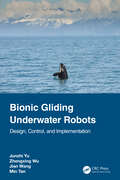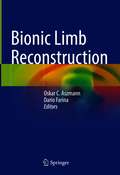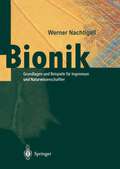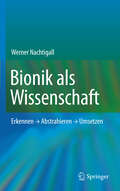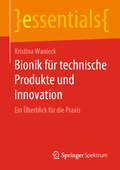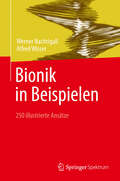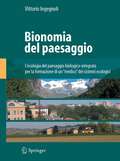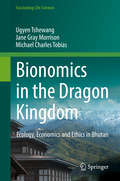- Table View
- List View
Bionic Gliding Underwater Robots: Design, Control, and Implementation
by Junzhi Yu Zhengxing Wu Jian Wang Min TanUnderwater robots play a significant role in ocean exploration. This book provides full coverage of the theoretical and practical aspects of bionic gliding underwater robots, including system design, modeling control, and motion planning. To overcome the inherent shortcomings of traditional underwater robots that can simultaneously lack maneuverability and endurance, a new type of robot, the bionic gliding underwater robot, has attracted much attention from scientists and engineers. On the one hand, by imitating the appearance and swimming mechanisms of natural creatures, bionic gliding underwater robots achieve high maneuverability, swimming efficiency, and strong concealment. On the other hand, borrowing from the buoyancy adjustment systems of underwater gliders, bionic gliding underwater robots can obtain strong endurance, which is significant in practical applications. Taking gliding robotic dolphin and fish as examples, the designed prototypes and proposed methods are discussed, offering valuable insights into the development of next-generation underwater robots that are well suited for various oceanic applications. This book will be of great interest to students and professionals alike in the field of robotics or intelligent control. It will also be a great reference for engineers or technicians who deal with the development of underwater robots.
Bionic Gliding Underwater Robots: Design, Control, and Implementation
by Junzhi Yu Zhengxing Wu Jian Wang Min TanUnderwater robots play a significant role in ocean exploration. This book provides full coverage of the theoretical and practical aspects of bionic gliding underwater robots, including system design, modeling control, and motion planning. To overcome the inherent shortcomings of traditional underwater robots that can simultaneously lack maneuverability and endurance, a new type of robot, the bionic gliding underwater robot, has attracted much attention from scientists and engineers. On the one hand, by imitating the appearance and swimming mechanisms of natural creatures, bionic gliding underwater robots achieve high maneuverability, swimming efficiency, and strong concealment. On the other hand, borrowing from the buoyancy adjustment systems of underwater gliders, bionic gliding underwater robots can obtain strong endurance, which is significant in practical applications. Taking gliding robotic dolphin and fish as examples, the designed prototypes and proposed methods are discussed, offering valuable insights into the development of next-generation underwater robots that are well suited for various oceanic applications. This book will be of great interest to students and professionals alike in the field of robotics or intelligent control. It will also be a great reference for engineers or technicians who deal with the development of underwater robots.
The Bionic Human: Health Promotion for People with Implanted Prosthetic Devices
by Frank E. Johnson Katherine S. VirgoAn integrated survey of best practices for the management of patients with implanted prosthetic devices and an insightful examination of the epidemiological, societal, and policy issues associated with their use. The devices covered range from breast, penile, vascular, and joint prostheses to cochlear, ossicular, and dental implants, and include cerebrospinal fluid shunts, cardiac valves, stents, and pacemakers. For each device, the authors consider its pros and cons, detail the best current strategies to keep implanted patients healthy, and evaluate the latest and most promising new diagnostic tests, Clinical counterpoints from distinguished authorities at major centers in the United States and Europe are offered throughout. Follow-up recommendations are summarized in a standardized format that allows comparative analysis and lays the foundation for controlled clinical trials and the eventual establishment of evidence-based guidelines.
Bionic Limb Reconstruction
by Oskar C. Aszmann Dario FarinaThis book presents the latest techniques in amputation rehabilitation and summarizes the most recent research findings in the field of bionic limb reconstruction. Divided into seven parts written by experts in the field, it provides valuable information on e.g. upper extremity injuries, psychological considerations, prosthetic engineering, and surgical and rehabilitation strategies. Illustrative figures and photos of real-life settings further assist understanding. This book is of interest not only for plastic surgeons, but also for hand surgeons, orthopedic and trauma surgeons as well as therapists, prosthetists and engineers.
Bionic Optimization in Structural Design: Stochastically Based Methods to Improve the Performance of Parts and Assemblies
by Rolf Steinbuch Simon GekelerThe book provides suggestions on how to start using bionic optimization methods, including pseudo-code examples of each of the important approaches and outlines of how to improve them. The most efficient methods for accelerating the studies are discussed. These include the selection of size and generations of a study’s parameters, modification of these driving parameters, switching to gradient methods when approaching local maxima, and the use of parallel working hardware.Bionic Optimization means finding the best solution to a problem using methods found in nature. As Evolutionary Strategies and Particle Swarm Optimization seem to be the most important methods for structural optimization, we primarily focus on them. Other methods such as neural nets or ant colonies are more suited to control or process studies, so their basic ideas are outlined in order to motivate readers to start using them.A set of sample applications shows how Bionic Optimization works in practice. From academic studies on simple frames made of rods to earthquake-resistant buildings, readers follow the lessons learned, difficulties encountered and effective strategies for overcoming them. For the problem of tuned mass dampers, which play an important role in dynamic control, changing the goal and restrictions paves the way for Multi-Objective-Optimization. As most structural designers today use commercial software such as FE-Codes or CAE systems with integrated simulation modules, ways of integrating Bionic Optimization into these software packages are outlined and examples of typical systems and typical optimization approaches are presented.The closing section focuses on an overview and outlook on reliable and robust as well as on Multi-Objective-Optimization, including discussions of current and upcoming research topics in the field concerning a unified theory for handling stochastic design processes.
Bionic Sensing with Artificial Lateral Line Systems for Fish-Like Underwater Robots
by Guangming Xie Xingwen ZhengIn this book, the authors first introduce two fish-like underwater robots, including a multiple fins-actuated robotic fish and a caudal fin-actuated robotic fish with a barycenter regulating mechanism. They study how a robotic fish uses its onboard pressure sensor arrays based-ALLS to estimate its trajectory in multiple locomotions, including rectilinear motion, turning motion, ascending motion, and spiral motion. In addition, they also explore the ALLS-based relative position and attitude perception between two robotic fish in a leader-follower formation. Four regression methods—multiple linear regression methods, support vector regressions, back propagation neural networks, and random forest methods—are used to evaluate the relative positions or attitudes using the ALLS data. The research on ALLS-based local sensing between two adjacent fish robots extends current research from one individual underwater robot to two robots in formation, and will attract increasing attention from scholars of robotics, underwater technology, biomechanics and systems, and control engineering.
Bionic Sensing with Artificial Lateral Line Systems for Fish-Like Underwater Robots
by Guangming Xie Xingwen ZhengIn this book, the authors first introduce two fish-like underwater robots, including a multiple fins-actuated robotic fish and a caudal fin-actuated robotic fish with a barycenter regulating mechanism. They study how a robotic fish uses its onboard pressure sensor arrays based-ALLS to estimate its trajectory in multiple locomotions, including rectilinear motion, turning motion, ascending motion, and spiral motion. In addition, they also explore the ALLS-based relative position and attitude perception between two robotic fish in a leader-follower formation. Four regression methods—multiple linear regression methods, support vector regressions, back propagation neural networks, and random forest methods—are used to evaluate the relative positions or attitudes using the ALLS data. The research on ALLS-based local sensing between two adjacent fish robots extends current research from one individual underwater robot to two robots in formation, and will attract increasing attention from scholars of robotics, underwater technology, biomechanics and systems, and control engineering.
Bionics and Sustainable Design (Environmental Footprints And Eco-design Of Products And Processes Ser.)
by Felipe Luis Palombini Subramanian Senthilkannan MuthuBionics by Examples: 250 Scenarios from Classical to Modern Times
by Werner Nachtigall Alfred WisserBionics means learning from the nature for the development of technology. The science of "bionics" itself is classified into several sections, from materials and structures over procedures and processes until evolution and optimization. Not all these areas, or only a few, are really known in the public and also in scientific literature. This includes the Lotus-effect, converted to the contamination-reduction of fassades and the shark-shed-effect, converted to the resistance-reduction of airplanes. However, there are hundreds of highly interesting examples that contain the transformation of principles of the nature into technology. From the large number of these examples, 250 were selected for the present book according to "prehistory", "early-history", "classic" and "modern time". Most examples are new. Every example includes a printed page in a homogeneous arrangement. The examples from the field "modern time" are joint in blocks corresponding to the sub-disciplines of bionics.
Bionik: Ökologische Technik nach dem Vorbild der Natur?
by Arnim Von GleichAls Begriff aus Biologie und Technik abgeleitet bezeichnet das Fachgebiet Bionik den Versuch, sich in der ingenieurwissenschaftlichen Forschung und beim konstruktiven Schaffen an evolutionär erprobten Strukturen, Funktionen und Strategien der Natur zu orientieren. Der Band Bionik gibt nicht nur einen Überblick über die Forschungsthemen und Probleme des an mehreren Universitäten vertretenen Faches, sondern informiert auch detailliert über die Arbeit zahlreicher Wissenschaftler, die sich in Deutschland mit der Übertragung und Anwendung von Entwicklungen der Natur auf Bereiche wie die Architektur, die Konstruktion von Schiffen, Fahrzeugen, Bauteilen und Maschinen oder auch die Verfahrens- Energie- und Klimatechnik beschäftigen.
Bionik: Grundlagen und Beispiele für Ingenieure und Naturwissenschaftler
by Werner NachtigallDieses umfassende Lehrbuch wendet sich an Studenten, Fachleute und Wissenschaftler und liegt somit im Niveau deutlich über den üblichen Sachbüchern zur Bionik. Es wird gezeigt, was Bionik ist, wie sie sich entwickelt hat, wie man Fragen stellt und was Bionik leisten kann. Im Detail diskutiert das Buch ausgewählte Beispiele aus den verschiedensten technologischen Bereichen. Es bietet auch einen Zugang zum wissenschaftlichen und gesellschaftlichen Umfeld der Bionik. Die vielfältigen Facetten dieser interdisziplinären Wissenschaft fügen sich in diesem anspruchsvollen Werk puzzleartig zu einer "Biostrategie in die Zukunft" zusammen. Seit dem Erscheinen der 1. Auflage hat sich die Bionik vielseitig weiterentwickelt. Das Buch wurde daher von Grund auf neu geschrieben, wobei einige bewährte Abschnitte beibehalten wurden. Der Umfang wurde verdoppelt, die Zahl der Beispiele vervierfacht.
Bionik: Grundlagen und Beispiele für Ingenieure und Naturwissenschaftler
by Werner NachtigallDieses umfassende Lehrbuch wendet sich an Studenten, Fachleute und Wissenschaftler und liegt somit im Niveau deutlich über den üblichen Sachbüchern zur Bionik. In einem umfangreichen allgemeinen Teil zeigt der Autor, was Bionik ist, wie sie sich entwickelt hat, wie man Fragen stellt und was Bionik leisten kann. Darauf folgen detaillierte Darstellungen von 40 ausgewählten Beispielen aus den verschiedensten technolgischen Bereichen. Die vielfältigen Facetten dieser interdisziplinären Wissenschaft fügen sich in diesem anspruchsvollen Werk puzzleartig zu einer "Biostrategie in die Zukunft" zusammen.
Bionik: Aktuelle Forschungsergebnisse in Natur-, Ingenieur- und Geisteswissenschaft
by Torsten Rossmann Cameron TropeaIn vielen Wissenschafts- und Technikzweigen ist der praktische Nutzen der Bionik anerkannt. Die Lösung technischer Probleme mit Hilfe biologisch motivierter Prinzipien wird erfolgreich praktiziert. Außen vor blieb jedoch bisher die Verständigung zwischen den beteiligten Wissenschaftszweigen.Dieses Buch gibt einen aktuellen Überblick über die unterschiedlichen Forschungsfelder, angefangen von Optimierungsstrategien in der Robotik über Adaptive Beinprothesen, Informationsverarbeitung in natürlichen und künstlichen Systemen, Optimierungsstrategien in der Industrie bis hin zu Philosophischen Aspekten der Bionik. Somit unterstützt es erstmals einen Diskurs zwischen den Disziplinen und ermöglicht einen Austausch zwischen Forschern unterschiedlicher Fachgebiete. Die Beiträge sind allgemein verständlich geschrieben und wagen einen Blick in die Zukunft spannender Forschungsaufgaben.
Bionik: Bionisches Konstruieren verstehen und anwenden
by Welf WawersDieses Lehrbuch erklärt anschaulich Anwendung aus der Bionik an zahlreichen Beispielen und vermittelt eine Vorgehensweise für die Identifizierung biologischer Lösungen und deren Übertragung auf technische Anwendungen. Basisinformationen der Biologie und Grundlagen der Konstruktionstechnik gewährleisten einen leichten Zugang zum Stoff. Mit dem 3D-Druck als Schlüsseltechnologie und der Thematisierung der Nachhaltigkeit geht das Buch zudem auf aktuelle Entwicklungen ein. Dieser ganzheitliche Blick soll den Leser zur Durchführung bionischer Projekte befähigen und motivieren.
Bionik als Wissenschaft: Erkennen - Abstrahieren - Umsetzen
by Werner NachtigallDer Begriff „BIONIK“ wird gerne als Kunstwort gekennzeichnet, zusammengesetzt aus BIOlogie und TechNIK. Bionik stellt einerseits ein Fach dar, in dem geforscht und ausgebildet wird, und kennzeichnet andererseits eine Sichtweise, nämlich die des „Lernens von der Natur für die Technik“. Darüber sind in der Zwischenzeit neben populär wissenschaftlichen Werken eine Reihe von Fachbüchern erschienen. Werner Nachtigall hat darin mit der 2. Auflage seines bei Springer erschienenen Buchs „BIONIK – Grundlagen und Beispiele für Ingenieure und Naturwissenschaftler“ einen Meilenstein gesetzt. In diesem Buch kennzeichnet er die Untergliederung des Fachs und bespricht detailliert dessen Forschungsgegenstände. Dagegen fehlte bislang eine Darstellung, die sich mit den erkenntnistheoretischen Grundlagen wie mit der pragmatischen Vorgehensweise der Bionik systematisch befasst, die ja mit der ihr eigenen Prinzip-Abstraktion zwischen der belebten Welt als Vor-Bild und der technischen Umsetzung als Ab-Bild vermitteln will. Das vorliegende Werk schließt diese Lücke mit drei großen Abschnitten: Biologische Basis: Erforschen, Beschreiben, Beurteilen. – Abstraktion biologischer Befunde: Herausarbeiten allgemeiner Prinzipien. – Umsetzung in die Technik: Prinzipvergleich, Konzeptuelles, Vorgehensweise.
Bionik für technische Produkte und Innovation: Ein Überblick für die Praxis (essentials)
by Kristina WanieckDie Bionik überträgt Wissen über biologische Vorbilder in technische Anwendungen und kann damit für die Entwicklung technischer Produkte und Innovationen genutzt werden. Es handelt sich dabei um einen der spannendsten Ansätze für zukünftige technische und gesellschaftliche Innovation, da das meiste Wissen aus der Biologie bisher noch ungenutzt ist. Kristina Wanieck fasst in diesem essential die wichtigsten Grundlagen der Bionik für ihre Anwendung in der Praxis zusammen. Darüber hinaus beschreibt die Autorin eine themen- und problemoffene Vorgehensweise – also unabhängig von einer konkreten Fragestellung. Diese Grundlagen sollen es ermöglichen, die Bionik für die verschiedensten Fragestellungen und Projekte zu nutzen.
Bionik in Beispielen: 250 illustrierte Ansätze
by Werner Nachtigall Alfred WisserBionik betreiben bedeutet, von der Natur für die Technik lernen. Die Wissenschaft „Bionik“ lässt sich in mehrere Teilgebiete untergliedern, von Materialien und Strukturen über Verfahren und Abläufe bis zu Evolution und Optimierung. Auf all diesen Gebieten gibt es bereits vielerlei Ansätze. In der Öffentlichkeit - und seltsamerweise auch in den naturwissenschaftlichen Fachdisziplinen - sind aber nur wenige wirklich bekannt. Dazu zählen der Lotus-Effekt, umgesetzt für die Verschmutzungsverminderung von Fassaden, und der Haischuppen-Effekt, umgesetzt für die Widerstandsreduzierung von Flugzeugen. Dabei gibt es aber heute schon hunderte von hochinteressanten Ansätzen, die eine Umsetzung von Naturprinzipien in die Technik zum Inhalt haben. Aus der Fülle dieser Ansätze sind für das vorliegende Buch 250 ausgewählt nach „Vorgeschichte“, „Frühgeschichte“, „Klassik“ und „Neuzeit“. Die meisten Beispiele sind neuerer Art. Jedes Beispiel umfasst in gleichartiger Gliederung eine Druckseite. Die Beispiele aus dem Bereich „Neuzeit“ sind in Blocks gegliedert, die den Unterdisziplinen der Bionik entsprechen.
Bionische Unternehmensführung: Mitarbeitermotivation als Schlüssel zu Innovation, Agilität und Kollaboration
by Rüdiger FoxDieses Buch zeigt, was die Prinzipien der Evolution mit Ameisen und dem Staat Bhutan gemeinsam haben. Mit dem „Gross Corporate Happiness“ Ansatz stellt es ein wissenschaftlich fundiertes und in der Praxis erprobtes Führungsmodell vor und erhebt den Mitarbeiter vom Kostenfaktor zum wirtschaftlich wichtigsten Treiber für nachhaltigen Unternehmenserfolg in der Wissensgesellschaft. Das Werk liefert Antworten auf die brennendsten Fragen der Unternehmensführung im Kontext von Globalisierung und Digitalisierung: Wie motiviere ich meine Mitarbeiter richtig? Wie steigere ich die Innovationsleistung meines Unternehmens? Wie schaffe ich eine Kultur von Kooperation, Agilität und Resilienz in Zeiten beständigen Wandels? Dr. Rüdiger Fox erläutert wie intrinsische Motivation im Wirtschaftskontext zum Business Case wird und schlüsselt dafür die organisationsinternen Rahmenbedingungen auf, die neben der Zufriedenheit und dem „Flow“, die Innovations- und Kooperationsfähigkeit der Mitarbeiter steigern. Aus seiner praktischen Führungserfahrung schöpfend, zeigt der Autor, wie Organisationen in komplexen und dynamischen Märkten damit deutlich effizienter werden.
BioNMR in Drug Research (Methods and Principles in Medicinal Chemistry #16)
by Raimund Mannhold Hugo Kubinyi Gerd FolkersThe vast progress made in the investigation of biomolecules using NMR has only recently been rewarded with the Nobel Prize for Kurt Wuthrich. Edited by a former coworker of Wuthrich, this book presents the theoretical background on NMR of biomolecules, plus the use of NMR techniques in determining the structures of proteins and nucleic acids. BioNMR spectroscopy offers a universal tool for examining the binding of an active substance to its target protein. Its use thereby benefits the rational development of drugs. This interaction can now be investigated in a hitherto unparalleled precision and displayed in 3D - an important prerequisite for the targeted development of new active substances. The latest methods for characterizing substance-receptor complexes are demonstrated backed by many case studies from pharmaceutical research. Thus it comes as no surprise that a large number of the authors are working for leading pharmaceutical companies. With its successful mixture of basic information and application strategies, coupled with many real-life examples, this is an invaluable guide for both NMR spectroscopists and pharmaceutical researchers.
Bionomia del paesaggio: L'ecologia del paesaggio biologico-integrata per la formazione di un medico dei sistemi ecologici
by Vittorio IngegnoliL’ecologia del paesaggio biologico-integrata, o meglio “Bionomia del Paesaggio”, si propone come un atto di rifondazione della disciplina iniziato dall’Autore una dozzina di anni fa, con l’appoggio di Richard Forman, basato sul riconoscimento del paesaggio come specifico livello dell’organizzazione della vita sulla Terra. A scala territoriale, in un determinato ambito geografico, il “paesaggio” si definisce come “integrazione di un insieme di comunità vegetali, animali ed umane e del loro sistema di ecosistemi naturali, seminaturali e antropico-culturali in una certa configurazione spaziale”, cioè come sistema iper-complesso che costituisce una entità vivente: non un insieme incoerente, quindi, di aspetti e di tematiche separate (acqua, aria, suolo, specie, inquinamenti) tra cui si possano trovare delle interrelazioni! Ciò porta, inevitabilmente, notevoli cambiamenti nelle modalità di valutare e gestire l’ambiente. Possiamo, infatti, riconoscere delle strutture e delle funzioni proprie di ogni paesaggio, ossia dei comportamenti peculiari che vanno oltre le classiche relazioni fra le componenti perché dovuti a leggi sistemiche. Si può così parlare di uno “stato di salute” e di una serie di sindromi (o patologie) del paesaggio. Questo fatto è assai rilevante, perché si è dimostrato che le alterazioni patologiche di un paesaggio, o di una sua parte, possono influire sulla salute umana, anche in assenza di inquinamenti! Prestiamo attenzione al fatto che si può intervenire sul territorio con le migliori intenzioni causando invece un danno! Ne consegue la necessità di studiare le “unità di paesaggio” con un metodo “clinico-diagnostico” e di considerare gli ecologi come “medici” dei sistemi ecologici, cioè “ecoiatri”.
Bionomics in the Dragon Kingdom: Ecology, Economics and Ethics in Bhutan (Fascinating Life Sciences)
by Ugyen Tshewang Jane Gray Morrison Michael Charles TobiasThis compact and elegant work (equally fitting for both academic as well as the trade audiences) provides a readily accessible and highly readable overview of Bhutan’s unique opportunities and challenges; all her prominent environmental legislation, regulatory statutes, ecological customs and practices, both in historic and contemporary terms. At the same time, Bionomics places the ecological context, including a section on animal rights in Bhutan, within the nation’s Buddhist spiritual and ethical setting. Historic contextualization accents the book’s rich accounting of every national park and scientific reserve, as well as providing up-to-the-minute climate-change related hurdles for the country.Merging the interdisciplinary sciences, engineering and humanities data in a compelling up-to-date portrait of the country, the authors have presented this dramatic compendium against the backdrop of an urgent, global ecological time-frame. It thus becomes clear that the articulated stakes for Bhutan, like her neighboring Himalayan and Indian sub-continental countries (China, India, Bangladesh and Myanmar) are immense, as the Anthropocene epoch unfolds, affecting every living being across the planet. Because Bhutan’s two most rewarding revenue streams derive from the sale of hydro-electric power and from tourism, the complexities of modern pressures facing a nation that prides herself on maintaining traditional customs in what has been a uniquely isolated nation are acute.
Bion's Dream: A Reading of the Autobiographies
by Meg Harris Williams'This book offers a definitive reading of Bion's remarkable autobiographical writings from a perspective embedded in the poetry of the ages, that of the Romantics in particular. It is at once learned and, utterly freshly, able to explore the inside story of Bion's life and mind. The volume is a distillation and elaboration of the work of many years. Whilst ostensibly an extended commentary on the autobiographical works themselves, it is also, in its own right, a tour de force, engaging, as it does, with the heart of the matter: with the development of a psychoanalyst, of a life, a self, a mind, thoroughly inward with the "dark and sombre world of thought".'- Margot Waddell, psychoanalyst and consultant child psychotherapist, Tavistock Clinic
Bion's Dream: A Reading of the Autobiographies
by Meg Harris Williams'This book offers a definitive reading of Bion's remarkable autobiographical writings from a perspective embedded in the poetry of the ages, that of the Romantics in particular. It is at once learned and, utterly freshly, able to explore the inside story of Bion's life and mind. The volume is a distillation and elaboration of the work of many years. Whilst ostensibly an extended commentary on the autobiographical works themselves, it is also, in its own right, a tour de force, engaging, as it does, with the heart of the matter: with the development of a psychoanalyst, of a life, a self, a mind, thoroughly inward with the "dark and sombre world of thought".'- Margot Waddell, psychoanalyst and consultant child psychotherapist, Tavistock Clinic
Bion's Legacy: Bibliography of Primary and Secondary Sources of the Life, Work and Ideas of Wilfred Ruprecht Bion
by Harry KarnacThis book forms a comprehensive bibliography of the works of W. R. Bion, and the other works that made some bearing of his life and thought. It discusses Bion's contribution to various disciplines beyond the psychoanalytic and psychotherapeutic.
